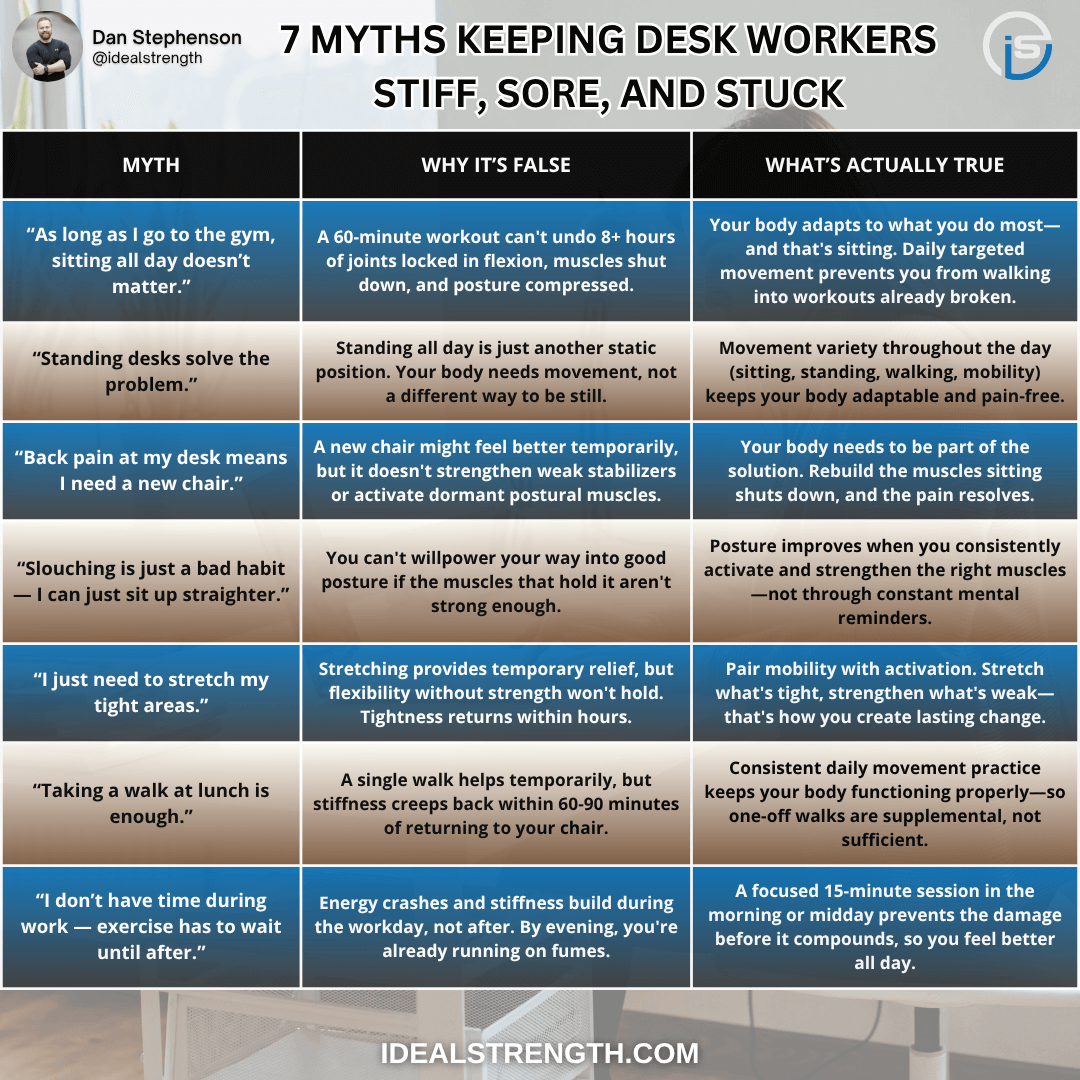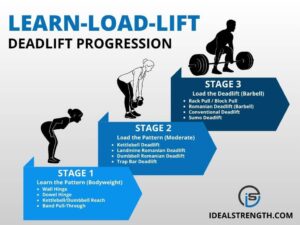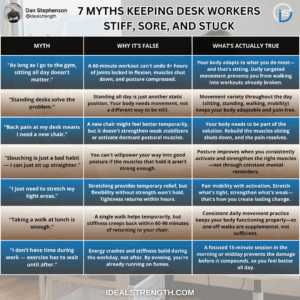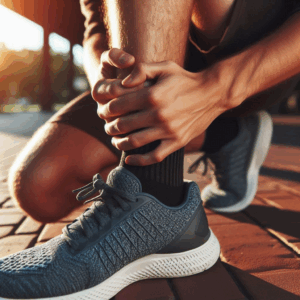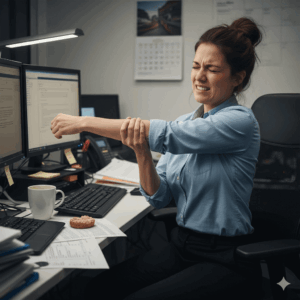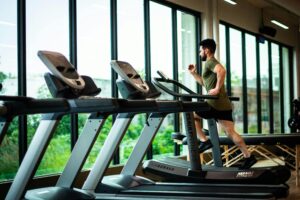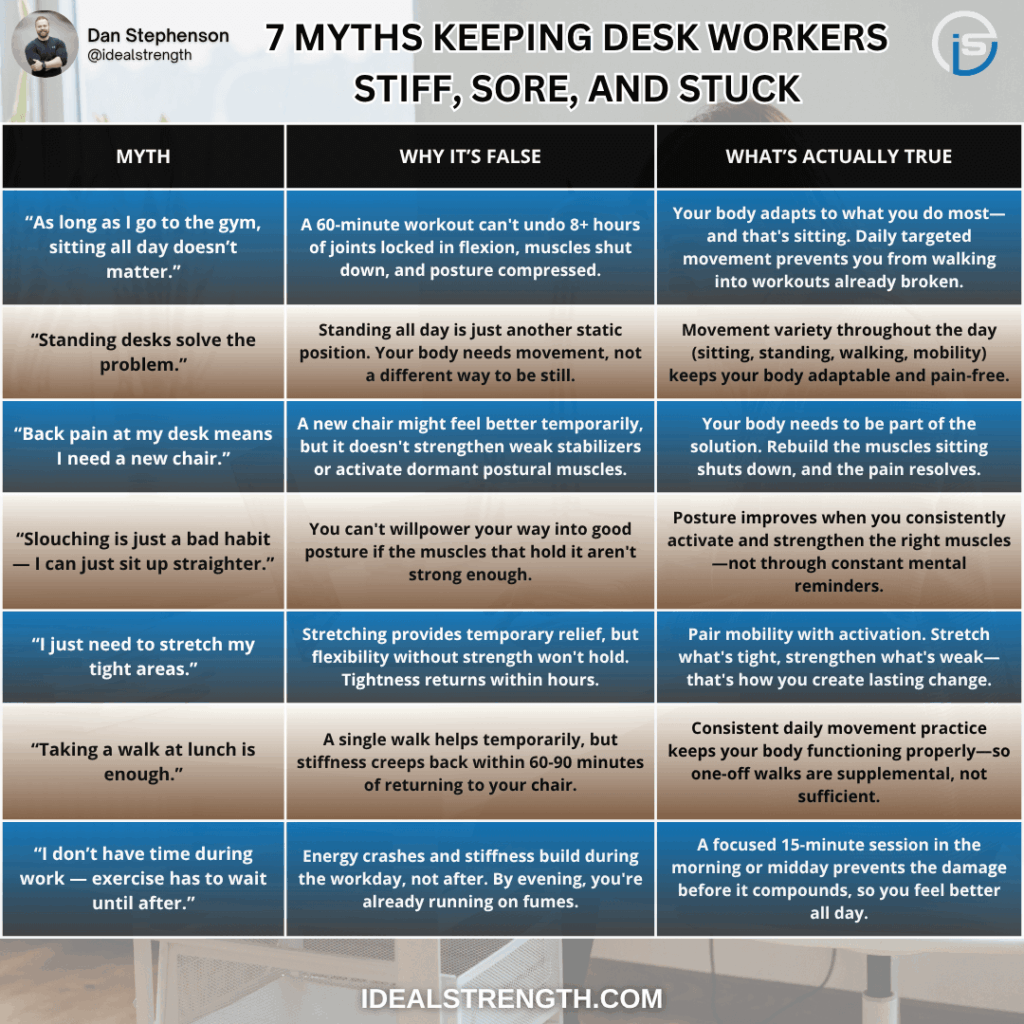You’re doing everything “right.”
You hit the gym 4-5 times a week. You invested in a standing desk. You stretch when you remember. Maybe you even have a foam roller gathering dust in the corner of your office.
So why do you still feel like absolute crap by 2 PM?
Why does your lower back ache after every meeting? Why do your hips feel locked up when you finally stand to grab coffee? Why does that 3 PM energy crash hit like clockwork, no matter how much caffeine you throw at it?
Here’s the uncomfortable truth most desk workers don’t realize:
Your body doesn’t adapt to your 60-minute workout. It adapts to the other 15 hours you’re awake.
If you spend 8+ of those hours locked in one position, hunched over a keyboard, spine compressed, hips flexed, shoulders rolled forward; that’s what your nervous system, joints, and posture are actually training for.
No matter how hard you train after work.
After decades of coaching desk-bound professionals, I’ve seen the same patterns play out hundreds of times. Smart, dedicated people who work out consistently but can’t figure out why their body feels progressively worse. People who invest in ergonomic equipment but still can’t shake the stiffness. People who stretch religiously but wake up tight the next morning.
The problem isn’t lack of effort. It’s that most of the conventional advice about “desk health” is built on myths that sound logical but don’t address how your body actually adapts to daily stress.
Let’s break down the 7 biggest myths I see keeping desk workers stuck—and what actually works instead.
Table of Contents
ToggleMyth #1: “As long as I go to the gym, sitting all day doesn’t matter.”
This is the big one. The myth I see sabotaging results more than any other, both at work AND in the gym.
Here’s what actually happens after 8 hours of sitting:
Your hip flexors lock short. They spend all day in a shortened position, pulling your pelvis into anterior tilt. This creates a cascade of compensations throughout your entire kinetic chain.
Your glutes shut down. When you sit, your glutes are getting turned off; stretched out and inactive. After hours of this, they become neurologically dormant. They forget how to fire properly and efficiently, even when you need them.
Your thoracic spine compresses. Gravity plus forward head posture creates a C-curve in your upper back. Your vertebrae compress, your ribcage can’t expand fully, and your breathing becomes shallow.
Your shoulders roll forward. Your chest muscles tighten, your upper back weakens, and your neck takes on tension it was never designed to handle.
Now you walk into your evening workout carrying all of this dysfunction.
You set up for squats, but your hips won’t open properly. Your glutes won’t activate. Your lower back takes over, trying to stabilize what your core and glutes should be handling.
You try overhead press, but your shoulders click and grind because they’re locked in internal rotation. Your neck tenses up because your upper back can’t support the load.
You leave the gym wondering why your lifts feel “off.” Why you’re not getting stronger despite training consistently. Why certain movements just don’t feel right.
The real problem: You’re not undertrained. You’re spending the first 15-20 minutes of every workout just trying to undo the tension and dysfunction from sitting all day.
By the time your body is actually ready to build strength, you’re already fatigued.
What Actually Works:
A targeted 15-minute session earlier in the day, before the damage compounds, that specifically addresses what sitting does to your body.
Open up the hip flexors that are locked short. Activate the glutes that have been dormant all morning. Decompress the spine. Reset shoulder position. Get your postural muscles firing again.
When you do this consistently, something shifts. You walk into your evening workouts feeling mobile and ready. Your squats feel smooth. Your shoulders move freely. You’re actually building strength instead of just managing tension.
And here’s the bonus: You feel better all day. That 2 PM energy crash? Less severe. That lower back ache? Dramatically reduced. Your focus and productivity? Noticeably sharper.
Because you’re not letting the damage accumulate in the first place.
Myth #2: “Standing desks solve the problem.”
Standing desks were supposed to be the solution. The fitness industry jumped on them. Companies installed them everywhere. Surely standing all day is better than sitting all day, right?
Not quite.
Standing all day = sitting all day. They’re both static positions.
Your spine doesn’t care whether you’re sitting or standing—it cares that you’re locked in one position for hours on end without meaningful movement.
In fact, standing all day creates its own set of problems: compressed lower back, tight calves, foot pain, and varicose veins from blood pooling in your legs.
The issue isn’t sitting versus standing. The issue is static versus dynamic.
What Actually Works:
Movement variety throughout the day. Sitting for a while, standing for a while, walking when you can, and—most importantly—hitting a focused movement session that addresses the specific postural dysfunction desk work creates.
Your body is designed to move through multiple positions throughout the day, not to hold one “correct” position indefinitely.
Use your standing desk. But don’t think it’s solving the underlying problem of tight hips, weak glutes, compressed spine, and rounded shoulders. Those issues require targeted corrective work.
Myth #3: “Back pain means I need a new chair.”
I get it. Your back hurts, and you’re sitting in your chair for 8+ hours a day. The logical conclusion: Get a better chair.
So you invest in a $1,200 ergonomic chair. It feels amazing for the first two weeks. The lumbar support is perfect. The adjustability is incredible.
Then the pain comes back.
Because here’s the thing: A chair can’t strengthen weak stabilizers or activate dormant glutes.
If your core is weak, your glutes aren’t firing, and your hip flexors are pulling your pelvis into anterior tilt, no chair in the world is going to fix that. You’re just going to be uncomfortable in a nicer chair.
Don’t get me wrong—your environment matters. Good ergonomics help. A quality chair is a worthwhile investment.
But your environment can only support your body. It can’t rebuild it.
What Actually Works:
Strengthen the exact muscles that sitting shuts down—the postural stabilizers that actually hold you upright without effort.
Your core needs to learn how to stabilize your spine under load. Your glutes need to reactivate and do their job of supporting your pelvis. Your upper back needs to be strong enough to hold your shoulders back naturally.
When these muscles are functioning properly, you can sit in almost any chair without pain. When they’re weak and inactive, even the best chair in the world won’t save you.
Your body needs to be part of the solution.
Myth #4: “Slouching is just a bad habit—I just need to sit up straighter.”
“Just sit up straight.”
You’ve heard it a thousand times. You’ve probably said it to yourself. You catch yourself slouching, you pull your shoulders back, you sit up tall… for about 90 seconds. Then you’re right back where you started.
You think it’s a discipline problem. A focus problem. If you just remembered to correct your posture more often, you’d be fine.
But here’s the reality: You can’t willpower your way into good posture if the muscles that hold it aren’t strong enough.
Telling someone with a weak upper back to “sit up straight” is like telling someone to hold a plank for 8 hours straight. Eventually, they’re going to collapse. Not because they’re lazy or undisciplined, but because the muscles simply can’t sustain that position.
Your postural muscles—your mid and lower traps, your rhomboids, your deep neck flexors, your multifidus—need to be strong enough to hold good posture without conscious effort.
When they’re weak, “sitting up straight” requires active mental focus. You’re fighting gravity and fatigue all day long. It’s exhausting, and eventually, you give up.
What Actually Works:
Consistently activate and strengthen your postural muscles so that good posture becomes the easy default and not a battle you fight all day.
When these muscles are strong and properly activated, sitting up straight doesn’t require willpower. It’s just how your body naturally organizes itself.
You’re not constantly reminding yourself to pull your shoulders back. Your shoulders just stay back because the muscles holding them there are doing their job.
That’s the difference between fighting your posture all day and having a body that supports itself.
Myth #5: “I just need to stretch my tight areas.”
You feel tight, so you stretch. Makes sense, right?
Your hamstrings feel like steel cables, so you do toe touches. Your hip flexors are screaming, so you do hip flexor stretches. Your chest is tight, so you do doorway stretches.
You feel better for 20 minutes. Then you sit back down at your desk, and within an hour, everything tightens right back up.
The problem? Stretching helps, but flexibility without strength won’t hold.
Here’s what’s often actually happening: Your hamstrings feel tight because your glutes and abs aren’t doing their job. So your hamstrings are overworking to stabilize your pelvis and control your hip movement.
You stretch them. They relax temporarily. Then you sit back down, your glutes stay dormant, and your hamstrings immediately go back to overworking because nothing else is picking up the slack.
The tightness isn’t the problem—it’s a symptom. Your body is compensating for weakness somewhere else in the chain.
What Actually Works:
Pair mobility with activation. Stretch what’s tight, then strengthen what’s weak so your body can actually hold the new range of motion.
Open up your hip flexors, then activate your glutes. Stretch your chest, then strengthen your upper back. Decompress your spine, then stabilize it with core work.
This is how you create lasting change instead of just temporary relief.
Your body needs both mobility and strength to function properly. One without the other leaves you stuck in the same cycle.
Myth #6: “Taking a walk at lunch is enough movement.”
Your lunch walk is great. I’m not going to tell you to stop taking it.
It gets your heart rate up, clears your mind, gives you a mental break from work, some fresh air, and gets you away from your desk for 20 minutes. All of that is valuable.
But here’s what it doesn’t do:
- It doesn’t open up hip flexors that have been locked short for 4+ hours
- It doesn’t activate glutes that have been neurologically dormant all morning
- It doesn’t decompress your thoracic spine or reset your shoulder position
- It doesn’t address the specific postural dysfunction that sitting creates
Walking is general movement. Sitting damage requires targeted, corrective movement.
After 4+ hours at your desk, your body isn’t just stiff—it’s adapted. Your hip flexors are short and tight. Your glutes are turned off. Your spine is compressed into a C-curve. Your shoulders are protracted forward.
A walk doesn’t address any of these specific adaptations. It’s light cardiovascular activity when you need postural correction.
Think about it this way: If you sprained your ankle, would you just “walk it off”? No, you’d do specific rehab exercises to restore proper function. The same principle applies here.
What Actually Works:
A structured daily movement practice that specifically targets tight hips, weak glutes, compressed spine, and rounded shoulders.
Mobility work that opens up what’s locked. Activation work that turns on what’s dormant. Strengthening work that rebuilds what’s weak.
This isn’t about moving more in general. It’s about moving with purpose addressing the exact adaptations your body makes to prolonged sitting.
Keep taking your lunch walks. They’re great for your overall health and mental clarity.
But don’t confuse general activity with corrective movement. Your body needs both.
Myth #7: “I don’t have time during work—exercise has to wait until after.”
This is the most common objection I hear: “I don’t have time during the workday. I’ll just work out after.”
I get it. Your schedule is packed. Back-to-back meetings. Deadlines. Projects. Client calls. There’s barely time to eat lunch, let alone work out.
But here’s the flaw in that logic:
The damage happens during the workday—not after.
By the time you get home at 6 PM, you’ve already spent 8+ hours with:
- Hips locked in flexion, hip flexors getting tighter by the hour
- Glutes completely dimmed down, forgotten by your nervous system
- Upper back rounded forward, thoracic spine compressed
- Energy draining steadily as your body fights to maintain basic function in a compromised position
Now you’re supposed to “make up for it” with a workout when you’re already running on fumes? When your body is already locked up and compensating?
It’s like waiting until your car is completely out of gas before you think about refueling. By then, you’re already stranded.
What Actually Works:
A focused 15-minute session in the morning or at midday, before the damage compounds and becomes the problem you have to solve later.
When you address the dysfunction early, several things happen:
1. You feel better all day. No more 2 PM energy crash. No more progressive stiffness. You stay mobile and energized through your entire workday.
2. Your evening workouts are actually productive. You’re not spending 20 minutes just trying to undo tension. You walk in ready to train and actually build strength.
3. You’re more focused and productive at work. Movement increases blood flow to your brain, improves cognitive function, and gives you mental clarity that translates directly to better work performance.
4. You sleep better. Your body isn’t carrying the accumulated tension and stress of a full day of sitting into bed with you.
The “I don’t have time” objection is really saying: “I don’t have time to feel good during the day.”
But 15 minutes isn’t a time problem. It’s a priority problem.
You have time. You’re just choosing to spend it feeling progressively worse throughout the day instead of taking 15 minutes to reset.
The Real Solution: The Desk Athlete Blueprint
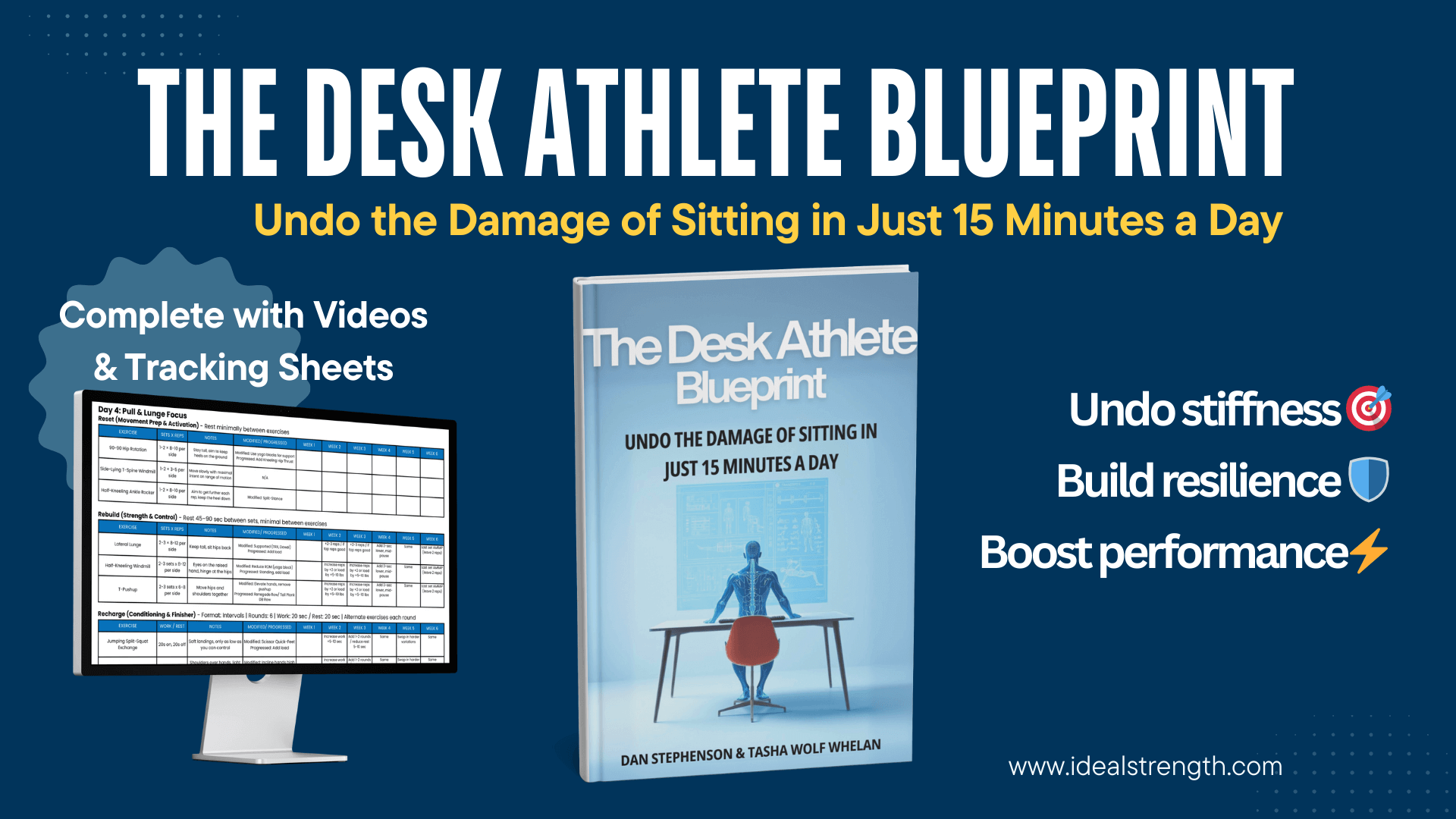
After decades of coaching desk-bound professionals, I’ve seen what works and what doesn’t.
The solution isn’t longer workouts. It’s not more equipment. It’s not expensive ergonomic furniture or standing desks or lunch walks.
The solution is a targeted 15-minute daily system that directly counteracts what sitting does to your body.
That’s exactly what I’ve built with The Desk Athlete Blueprint.
It’s a three-phase system designed specifically for working professionals:
Phase 1: Reset (5 minutes)
Targeted mobility work that opens up the exact areas sitting locks down—your hip flexors, thoracic spine, and shoulders. This isn’t random stretching. It’s specific corrective movement that addresses the postural adaptations your body makes to prolonged sitting.
Phase 2: Rebuild (6-8 minutes)
Activation and strengthening work for the muscles that sitting shuts down—your glutes, core, and upper back. These are the postural stabilizers that actually hold your body in proper alignment without conscious effort. When they’re strong and functioning properly, good posture becomes automatic.
Phase 3: Recharge (4-6 minutes)
Short, strategic HIIT intervals that boost circulation, increase energy, and prime your nervous system. This isn’t about burning calories—it’s about getting your body fully awake and ready to perform, whether that’s at your desk or in the gym later.
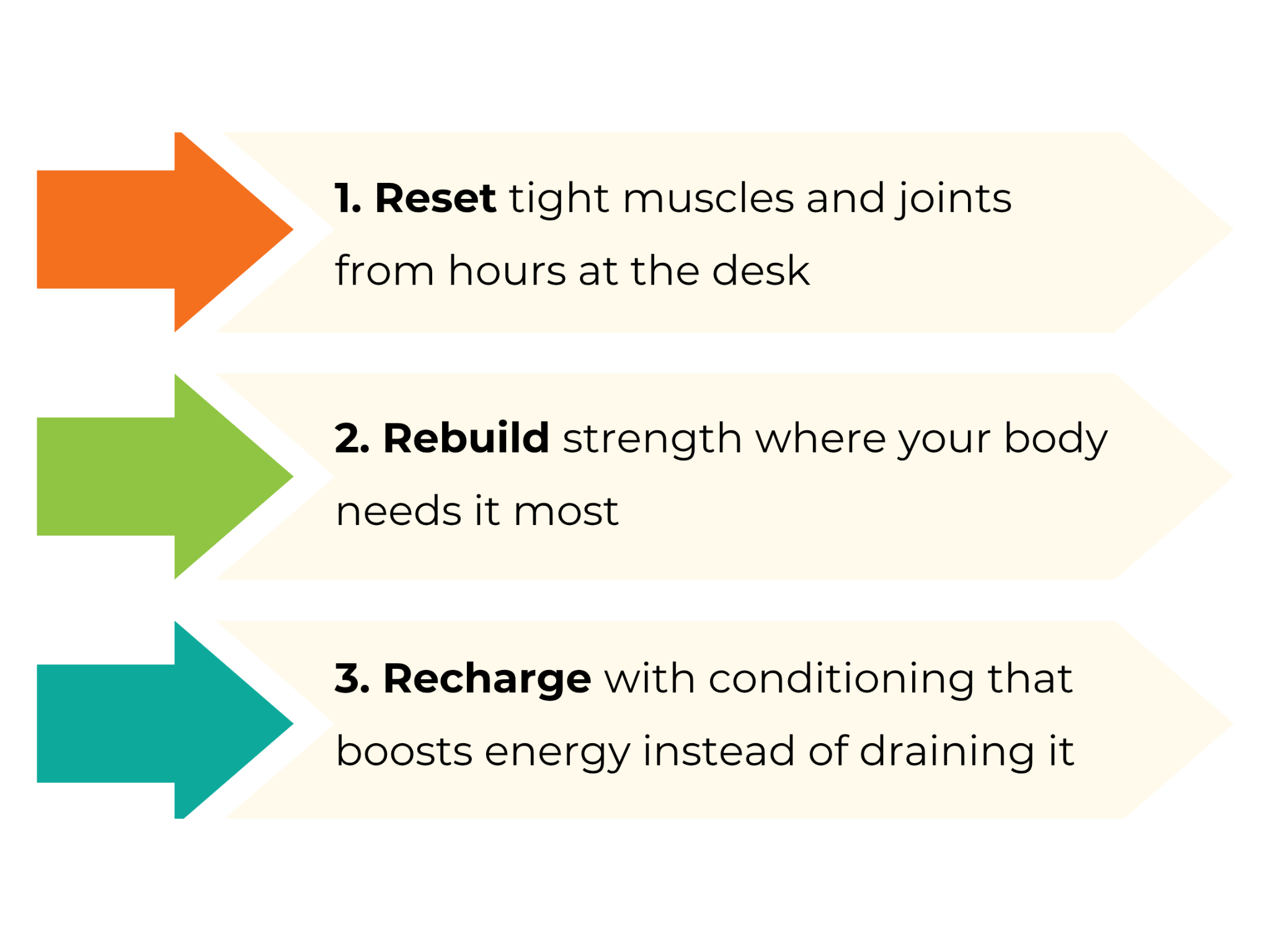
Each phase builds on the previous one, creating a complete session that:
✅ Undoes the damage of sitting before it compounds into chronic pain and dysfunction
✅ Prepares your body to move better in the gym (or just in daily life) by addressing dysfunction before you train
✅ Boosts energy and focus for the rest of your workday through increased blood flow and nervous system activation
✅ Takes just 15 minutes and requires no gym, minimal equipment, and can be done anywhere
This isn’t theory. It’s the exact system I’ve used with hundreds of clients who were stuck in the same cycle you might be in right now.
As a coach, Myth #1 is what I help clients break through most often. When clients neglect their posture throughout the day, we spend half the training session just trying to get them into better positions: undoing hip tightness, waking up dormant glutes, decompressing their spine.
But clients who adopt daily homework like The Desk Athlete Blueprint? They show up ready to train. Their hips are mobile. Their glutes fire properly. Their posture is already reset. We can actually spend the session building strength instead of managing dysfunction.
The difference is night and day.
What You Get With The Desk Athlete Blueprint
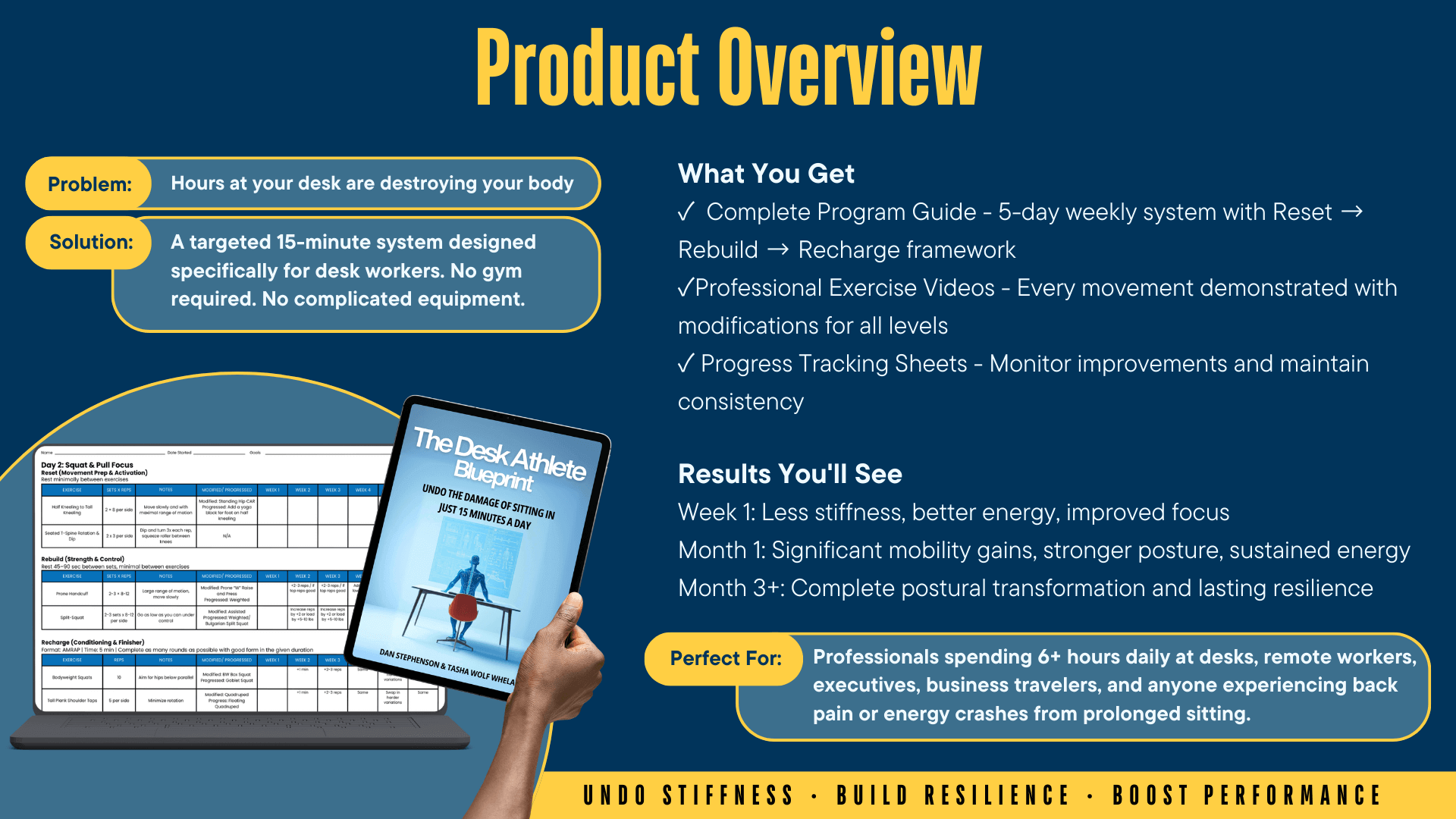
The Complete 15-Minute System The three-phase Reset → Rebuild → Recharge framework with clear instructions, exercise demos, and coaching cues for every movement.
Progressive Programming Week-by-week advancement strategy with RPE guidelines, “when to progress” decision trees, and troubleshooting for plateaus. You’re not doing the same routine forever—you’re getting stronger and more capable over time.
Lifestyle Integration Strategies How to maintain your routine during business travel, high-stress work periods, and while integrating with existing fitness programs. Plus long-term sustainability planning for career-long health.
The Science Behind Your Results Research citations proving 15-minute sessions work as well as hour-long workouts, plus evidence for improved workplace performance, cognitive function, and long-term career resilience.
Professional Performance Bonuses Energy management protocols for all-day productivity, posture improvement strategies for video calls and presentations, stress relief through strategic movement breaks, and focus enhancement through exercise timing.
This Is For You If:
You’re an executive, entrepreneur, remote worker, or anyone who spends their day at a desk but refuses to let your career come at the cost of your health and energy.
You’re tired of accepting stiffness, pain, and afternoon energy crashes as “just part of the job.”
You want to feel as strong, mobile, and energized at 5 PM as you do at 8 AM.
You want your gym sessions to actually build strength instead of just managing tension.
You want a system that works with your demanding professional schedule, not against it.
Ready to Move Better and Feel Stronger?
The Desk Athlete Blueprint launches today.
This is a one-time investment in a system that will pay dividends in energy, productivity, and physical resilience throughout your entire career.
No more waking up stiff. No more 2 PM energy crashes. No more walking into workouts already broken.
Just 15 minutes a day to undo the damage of sitting and keep your body—and your potential—in motion.
Get The Desk Athlete Blueprint Here → https://shop.idealstrength.com/p/desk-athlete-blueprint
Your most productive, pain-free, energized professional self is waiting.
Let’s get you there.
Questions? Reach out at [email protected] – I read and respond to everything personally.

